Manage your responses more effectively with these pointers.
 Reporters use a variety of ways to reach companies and their spokespeople. Some rely solely on relationships they’ve made for their story sources. Others take to social media to pose a question and let the public help direct them to sources, or they may utilize media relations query tools. These tools allow reporters to pose questions and get a variety of responses from sources, as well as search for spokespeople who may have knowledge that applies to a story they’re working on. Public relations professionals use resources like these, so here are our top five tips for responding to reporters’ queries.
Reporters use a variety of ways to reach companies and their spokespeople. Some rely solely on relationships they’ve made for their story sources. Others take to social media to pose a question and let the public help direct them to sources, or they may utilize media relations query tools. These tools allow reporters to pose questions and get a variety of responses from sources, as well as search for spokespeople who may have knowledge that applies to a story they’re working on. Public relations professionals use resources like these, so here are our top five tips for responding to reporters’ queries.
Audio: Listen to this article.
- Be selective.
Be selective about the queries we respond to — the client is busy and so are we as public relations professionals. Look for the right fit. This includes looking into the outlet to verify what tier the news media outlet may fall under and other articles or topics the reporter has covered. You may find that while the topic may align, the geographic reach of the outlet may not make sense for your company to respond.
- Respond early and often.
Respond quickly and follow up because the squeaky wheel gets the grease. There are some media relations query tools that only allow you to converse within the platform at first, meaning you must respond early to catch the reporter’s eye so you can converse outside the platform. Once the deadline passes, for example, one reporter query source tool stops allowing you to email the contact.
- Prioritize location and industry.
It’s important to prioritize the right geographic location and industry media. There are other PR pros who are also actively responding to these queries. Be selective to what fits the client’s needs and journalist’s criteria.
- Identify trending topics.
While you might opt to not respond (the outlet or part of the query may not apply to your client’s needs) or make a reporter’s deadline, however, that doesn’t mean you can’t use a reporter’s query to your client’s benefit. Use these queries to identify trending topics you can tailor to your client’s criteria, and then use it to pitch the topic to other media outlets and use it for blog and social media posts.
- Repurpose.
Once you develop a pitch, it’s possible to repurpose it when you see similar queries from other outlets. Keep a file of your past reporter query pitches by client to help out with this. As mentioned above, these pitches can also be used for blog and social media posts. Depending on the topic, it could also be a news release.
A reporter’s query can give you and your client an opportunity to be included in a news story or outlet you may not have considered. Reporter queries can also come from freelancers who work for an outlet. This can allow you to build relationships with these reporters who may write for multiple outlets.
Are you ready to get involved with your industry’s trending news and grow your external audience? Ask our experienced team at Axia Public Relations how we can help.
 Clients love Marjorie’s work ethic, speed and diligence. She has worked with Axia Public Relations since October 2011. Marjorie graduated from Rockhurst University with a Bachelor of Arts in communication and loves to cheer for her hometown Kansas City Royals. Learn more about Marjorie.
Clients love Marjorie’s work ethic, speed and diligence. She has worked with Axia Public Relations since October 2011. Marjorie graduated from Rockhurst University with a Bachelor of Arts in communication and loves to cheer for her hometown Kansas City Royals. Learn more about Marjorie.
Photo by Andrea Piacquadio
Topics: media relations, earned media, news media



Comment on This Article